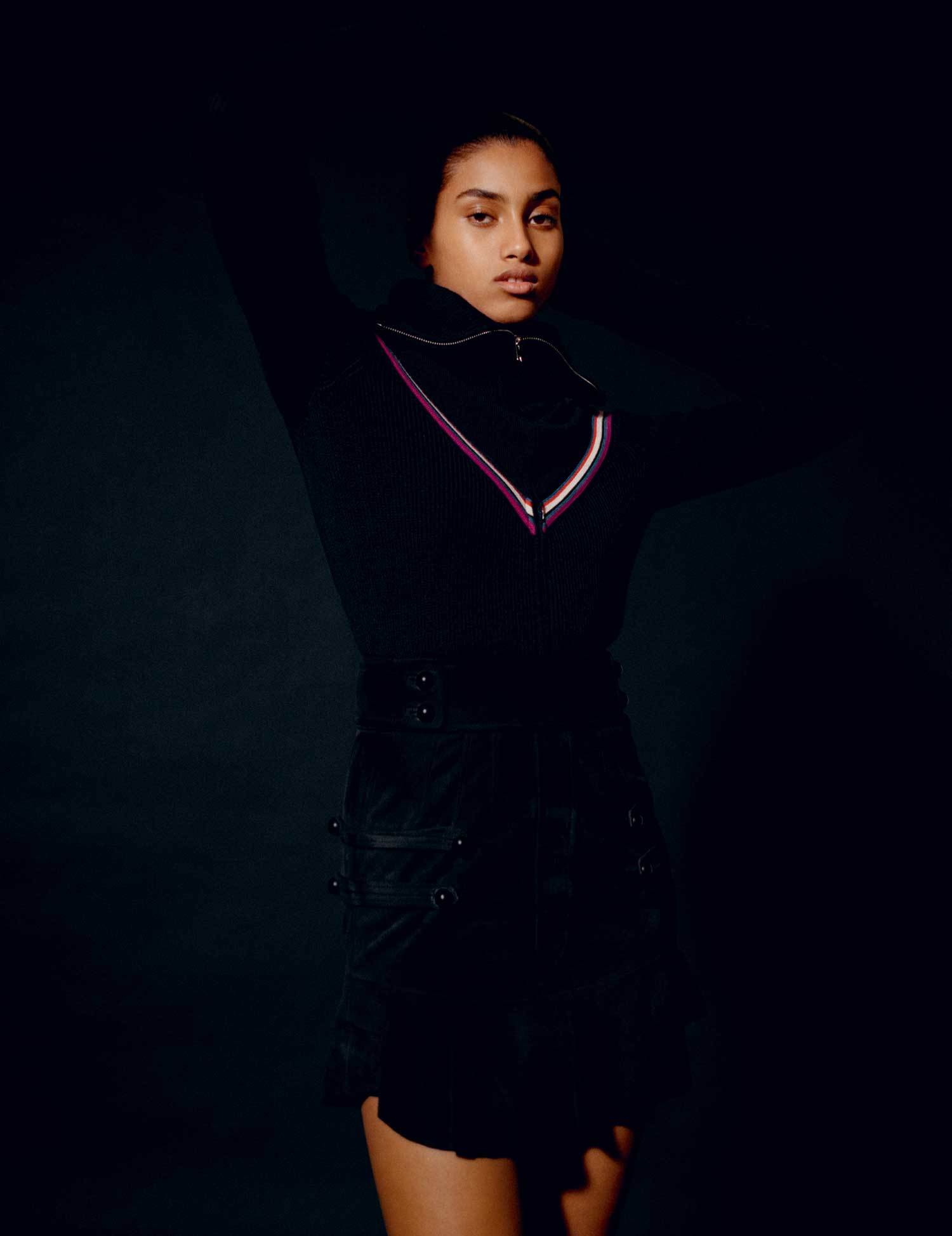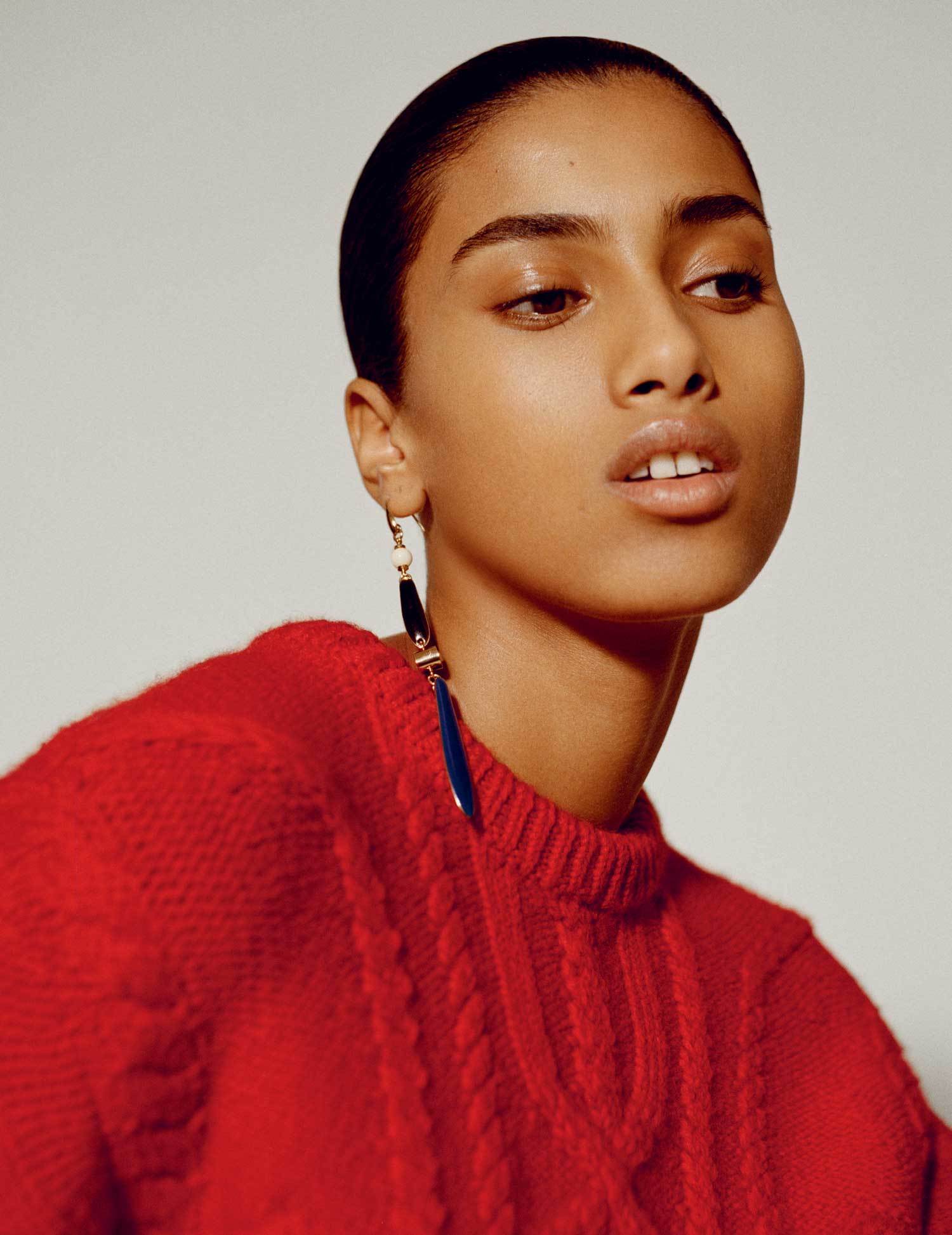Isabel Marant is the French queen of fashion fusion, who dreamed up the heeled sneaker and gave us a Gallic Parisian chic. From these diverse elements, a picture is starting to emerge, that of a business-savvy bobo (bohemian-bourgeois—the combination says it all) who has single-handedly managed to update the mythical figure of the Parisienne—and who is capable of making a single collection as appealing to the Kardashians as to the snobbish art crowd in Paris’ Le Marais.
“Who would have thought my clothes could attract both Lou Doillon and Kendall Jenner?” she giggles. Sitting cross-legged, with no discernible make-up, un-dyed hair, a hand-rolled, unfiltered extinguished cigarette dangling from her lips, she looks more like an art student than one of the most successful women’s designers on the planet. Her spring/summer 16 show held in the picturesque Palais Royal gardens before the eyes of Parisian fashion aficionados —including long-term client Caroline de Maigret—combined touches of 80s sportswear, North Indian craftsmanship, and much menswear. As always, it stayed true to the winning formula she initially put in place 21 years ago when she launched her first collection. Starting out with knits, she initially only designed for her friends, inspired mainly by the bilingual daughters of Serge Gainsbourg.

Following the footsteps of Rive Gauche icon Ines de la Fressange (another expert at mixing high and low, Monoprix and Chanel), yet also in stark contrast, Marant imagined a girl who had swapped her trench coat for a vintage army jacket, her stiletto heels for sneakers, her taxi for a Vespa. “It started with a look at my own life and needs and turned into a slightly sociological consideration of the city, and the way women live in it: like myself, a lot of my core clientele might live in Belleville (Paris’ buzzing Chinatown), listen both to Shamir and Nina Hagen and would rather throw their own house party than go to a fancy club” she says, adding that “there are no rules of course, but there is one reality: today one needs to be both elegant and street smart.”
A world away from the pricey Café de Flore at the heart of Saint-Germain-des-Prés, her work mirrored the changing needs of a capital that was both increasingly gentrified and hit by a recession—a city with shifting boundaries, both geographical and stylistic. Take the platform-heeled sneaker, which she created in 2010, which found worldwide success and was adopted by the likes of Beyoncé, Kate Bosworth, and Jessica Alba: it filled a need for a comfortable heel and catered for a girl equally interested in high fashion and streetwear: “It started when I was young: I made myself look taller by adding layers of sliced cork inside my shoes,” she laughs. “Those sneakers were also a nod to my love of hip hop fashion, which was a big influence when I was growing up in Paris.” A powerful combo to say the least: to this day, the shoe has been copied by everyone from Nike to Giuseppe Zanotti, while she says she now “can’t even look at them anymore! The essence is still there though: heels so comfortable they are worn like tennis shoes and vice-versa – sportswear chic enough to be worn at the front row of a fashion show.”

For Alice Litscher, a professor of fashion communication and theory at Paris’ Institut Français de la Mode, “Isabel’s work ties back to the essence of French fashion: throughout history, designers used clothing to comment on the world-at-large rather than mirror what tourists expect from it. From Paul Poiret’s Grecian, corset-less cuts to Coco Chanel’s polo-inspired knits, they offered practical solutions inspired by other countries.” Her style is marked by consistent, practical hybrids: “You find the same products reworked every season—the smart it-piece, the affordable basics, the ethnic jacket and the menswear-inspired outerwear. Her fashion is stable and reassuring; for her, commercial isn’t a dirty word, it’s in tune with the way people consume products today,” Alice adds.
Indeed, over the last 21 years, her slow and steady progression has led her to worldwide success, and an explosion of popularity in America since her collaboration with H&M in 2013 (after Lanvin, Margiela, Viktor & Rolf, her urban capsule for the Swedish giant revisited some of her bestsellers, leading some people to camp outside stores overnight). Marant now has 16 boutiques around the world, 800 selling points, and 6 collections including a second diffusion line, Isabel Marant Etoile. Even her second- hand clothes are sought-after: according to vintage shopping destination Vestiaire Collective, its number-one clothing brand throughout America is Isabel Marant.

“I suppose there is something quite stable about my design, an identity that doesn’t reinvent itself. It’s something tough and hard to achieve, it can’t be built overnight. Today you are surrounded by brands and products as transient as an Instagram post. The longevity of a brand is the hardest thing in the world to sustain.” To underline the point, she talks about her husband, bag designer Jérome Dreyfuss, and mentions both his rapid success—and subsequent difficulties. “Fashion pushes young kids to the forefront, and forgets all about them a few seasons later. Or those new stars are unable to cope with the pace. You may have all the talent in the world, but you are too young and too small a company to know the ropes, get deliveries made on time, get paid, not get ripped off. It’s unbelievably hard,” she says.
Several designers have emerged from her fashion house. Take Léa Peckre, who studied at Belgium’s illustrious La Cambre school, and won ANDAM’s first collection prize in 2015. Although Léa’s style, both sombre and minimalist, is quite different from Marant’s, she feels Isabel has taught her vital things: “Fashion is for life rather than a museum, it’s a very realistic thing. She taught me to consider the garment as an object, a product rather than a merely intellectual expression. It’s something conceptual schools never teach you.”

Isabel, who remains unfiltered and has often been quoted saying she’s anti-consumerist, leftish, and famously spends every weekend with her family in an electricity and water-less log cabin in the countryside by a river, has found she can reconcile her beliefs and her love of fashion: “A successful fashion item will make its wearer happier and improve his or her life in invisible ways. I’m not looking to be the most famous, the coolest, the most anything, but hopefully provide sartorial solutions to everyday situations. And that those will resonate throughout countries and ages.” She’s on a good path to achieve just that.
Credits
Text Alive Pfeiffer
Photography Letty Schmiterlow
Styling Julia Sarr-Jamois
Hair Cyndia Harvey at Streeters using Moroccan Oil
Make-up Florrie White at D+V Management using Clinique
Nail technician Michelle Humphrey at LMC Worldwide using Maybelline New York
Photography assistance Yi Chen, Mona Butt
Styling assistance Harriet Byczok
Casting Angus Munro at AM Casting (Streeters NY)
Printing Luke at Touch
Production Artistry London
Model Imaan Hammam at Viva
Imaan wears all clothing Isabel Marant.
